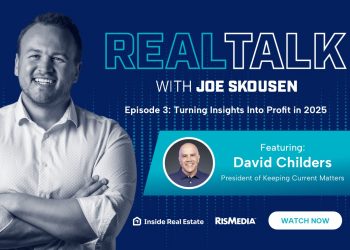Parts I & II
Editor’s Note: We are rerunning Part I of this article from Wednesday, July 23 because of some corrections that needed to be made. Part II follows where the article ended last week.
Part I
By Marylyn B. Schwartz
RISMEDIA, July 30, 2008-Robert Pardes’ resume reads like an entire Who’s Who for one. He is a Certified Public Accountant, Attorney, banking management, real estate finance and related capital markets expert. His company, Recourse Recovery Management Services, provides strategic and tactical services relating to impaired mortgage backed securities investments.
Interviewing Pardes was both fascinating and challenging. Fascinating in that he is a wealth of knowledge and wisdom, and challenging in that his expertise is exemplary, far reaching and comprehensive; capturing the crucial elements, in everyday understandable terms, was tough…
Marylyn B. Schwartz: “Robert, it is an honor to be chatting with you about subjects that have filled thousands of texts and newspapers worldwide. We are attempting to render some hot topics into pure knowledge that may help our readers work more effectively within the real estate and related industries. That begs the questions, who are and what is going on with Fannie Mae and Freddie Mac?
Robert Pardes: “First, let’s define what they are. Federal Home Loan Mortgage Corporation (Freddie Mac/FM) was created in 1970 by Congress primarily to serve thrifts in providing liquidity, stability and affordability to the nation’s mortgage markets using private, not public, capital. Congress’ creation of Freddie Mac was a sophisticated and creative approach to the longstanding national goal of promoting homeownership, and a recognition that historically the strictly private markets had failed to provide a stable and affordable supply of credit for residential housing. Federal National Mortgage Association (Fannie Mae/FM) was created in 1938 as part of FDR’s New Deal. The collapse of the national housing market in the wake of the Great Depression discouraged private lenders from investing in home loans. Fannie Mae was established in order to provide local banks with federal money to finance home mortgages in an attempt to raise levels of home ownership and the availability of affordable housing. They do their jobs by buying loans from banks, thrifts (S&Ls) and mortgage bankers and either holding these loans in their portfolios or securitizing them (protecting the loans with guarantees against defaults) and selling them to investors worldwide. These entities eventually became privatized, yet they remained federally chartered meaning that they were beholden to private investors in terms of generating growth in earnings and share value and, at the same time, obligated by their Federal Charter to meet their public mission/objectives that were often in conflict. They are known as government sponsored enterprises (GSEs.) By privatizing these entities, two distinct and significant advantages were achieved. First, the agencies gained virtually unlimited access to low cost government funding as a result of the implicit guarantee associated with GSE status. Second, they were allowed to conduct activities with substantially greater leverage and lower capital levels. These advantages fueled unbridled growth in terms of market share and asset size. The government was in essence a ‘sugar daddy’ for funds in perpetuity.”
MBS: “Having private ownership and at the same time being required to undertake a public mission are competing interests that have proven difficult to manage. How, if at all, does that implicit funds guarantee feed into the present public ‘crisis in confidence’ that now these agencies are on the brink of ruin and/or running amuck by virtue of not abiding by sound banking practices?”
RP: “There are headlines everywhere that leave the reader with the perception or reinforce the reality that these entities are undercapitalized to absorb losses relating to loans they own or guarantees they issued to other investors. They own or guarantee 5 trillion of mortgage debt, and that comprises half of the total outstanding mortgage debt nationally. They have combined capital of 55 billion. When you do the math, on the surface, it looks pretty grim. The fear is that they could ‘eat up’ the capital quickly. If 10% of loans were in default and 1% of defaults equal approximately 25 billion in liability, a mere 3% loss rate would more than wipe out cash on hand.
The national default rate of loans (that is past due or in foreclosure) as of 6/1 was 8.8%. However, Fannie Mae’s and Freddie Mac’s holdings in the risky-loan market (the so called sub-prime or non-prime loan) are nominal. Where it gets sticky, however, is that all their existing capital bases and revenues remaining are inadequate to absorb losses associated with the rapidly declining residential market conditions. In the event that their capital was to continue to show signs of depletion, international or other investors may have significant reservations about borrowing because the cost of borrowing rises when capital depletes. Liquidity and demand for FM and FM securities would decline and they would be compromised in their ability to support the housing market’s need for loans. Does the government provide direct investment to the entities (what amounts to a blank-check bailout) or does FM and FM look elsewhere to raise capital? There is presently a boisterous debate on this issue on Capitol Hill as well as on every talking-head Sunday news show. It is not within our imagination for these entities to fail. However, a bailout is not going to resolve the underlying causes of the problems, and now would be the right time to look at those root causes and make needed and overdue changes even if and when the needed liquidity is provided.
The fact is that when the government bailed out Bear Stearns, that act turned that ‘implicit’ guarantee of funds flowing in perpetuity from the government to FM and FM into an ‘explicit’ guarantee. If Bear Stearns was not going to be allowed to tank, how could anyone expect that FM and FM would?”
MBS: “Those of us who are the gatekeepers of the real estate profession are watching, with great interest, to see how this unfolds. One has to wonder if we bailout FM and FM without curing the ills that brought about this historic turn of events. What’s next? US car manufacturers come to mind… Turning to a tangential topic, what is the possible impact of banks having to take back previously bundled and sold loans (so called mortgage backed securities) from investors by virtue of those loans having been securitized by fraudulent documentation, and the subsequent investors realizing losses due to many of those loans falling into the failed sub-prime category?”
RP: “Notwithstanding press concerns regarding capital levels on hand of many banks, the impact on the real estate profession is a non-event. There are still many banks that are willing and ready to provide mortgage loans to qualified borrowers. Rather than to worry about more bank failures, real estate and banking professionals should be focused on creating a menu of products to meet the core housing demand. It is crucial to keep in mind that we have had sub-prime type loans for many years. However, the balance between prime loans and sub-prime loans was maintained in a responsible way. The number of sub-prime loans granted mirrored the demographic of persons for whom those loans were created: 10-15%. It is only when banks and thrifts began to offer sub-prime loans to a broader demographic and simultaneously lowered the lending criteria for obtaining a loan did the problems begin en masse. Non-prime lending reached upwards of 40% of all loans.
There are no doubt going to be lending institutions who will continue to realize loses as a result of poorly securitized MBSs. $100 billion or more of additional losses is not unlikely. The impact to the marketplace is likely to be that banks will have to dedicate ‘the gift’ bestowed by the Federal Reserve of lower borrowing costs to fund loss reserves rather than providing more funds to the housing market. There is little doubt that where there is the possibility for proving any fraudulent lending practices, those possibilities will be fully investigated over time.”
Part II
MBS: “As you know, effective March 6, the FHA increased its loan limits on jumbo mortgages to a maximum of $729,750. As it became more difficult to get a mortgage loan, this revision infused some well-needed capital into the mix. What effect is this having on the mortgage industry to date?”
RP: “It is very important for the real estate professional to make his/herself familiar with FHA lending guidelines. As mentioned, there are many thrifts and banks that are sound and well capitalized. When you combine that with the advantages of FHA funding, the banking industry is well positioned to meet the needs of a broad-base of demand. That is not to say that the loss of what amounts of 10-15% of the sub-prime market is not a big deal. Realtors® need to use a talented mortgage broker who knows all aspects of the market and is able to explore options with the applicant as well as help educate the agent. In these challenging times I would advocate that purchase agreements would benefit from the inclusion of statement of income, FICO score, the entity funding the loan and other pertinent information.”
MBS: “While there are those who still refuse to acknowledge the existence of an actual recession, those of us feeling the crunch say that who cares what you call it, it is causing great pain regardless. Talk about your view of the present market conditions.”
RP: “The government has reported accelerated inflation rates due to energy and food costs. Even those reported rates grossly underestimate the inflation rate experienced by average American families. Despite the decreases in the cost of flat-screen TVs, we’re up against the double-digit increases in milk, gasoline, healthcare, petroleum-based products, education and household necessities. The real household inflation rate is more like 20% and is combined with flat and in some cases declining income levels. The combined effect produces an outcome that is far more damaging than even that of a recession by its definition of two consecutive declining quarters of growth.
There is an old saying, ‘It’s a recession if you’re reading about it. It’s a depression if you’re living under the twin evils of unemployment or reduced income and double digit inflation.’ There is empirical evidence that unemployment rates are increasing. The government reported rates do not include those who have abandoned the job search or are underemployed at reduced income and therefore reduced spending power. We’re not a nation of whiners as has been claimed. We are a nation experiencing real pain. ”
MBS: “Do you have some concrete recommendations to improve the housing market?”
RP: “Political stalemates, confused monetary policy and the absence of participation of real estate sales and finance industry professionals with hands-on experience in the process of creating solutions for residential real estate woes has proven to be an impediment in taking action to remediate the problems as quickly as possible.
My prescription for addressing the severe conditions impacting the housing market are three fold:
– Focus on liquidity, not interest rates. Rates are higher now than they were last year, and it has not helped to cure the ills.
– Support the demographics that comprised the core housing demands prior to the bubble.
– Allow the unavoidable pain to run its course. Clean up the foreclosures as quickly as possible so that we can begin to move back to more normal housing demands.
In addition, and as a direct result of this current crisis, lending regulations have swung to the right. It is incumbent upon all real estate professionals to understand that they are under tremendous scrutiny, deserved or otherwise. They are being vilified as part of the cause of this crisis and should think about their exposure. Their professional conduct needs to be above the appearance of any impropriety. Simple vigilance is not enough. We need the highest levels of integrity and caution. One transaction could result in a regulatory investigation that could sink a career or even a company. Everything should be put in writing and all RESPA rules should be known inside and out and followed to the letter of the law. Ignorance is no excuse of the law. It is up to the individual to monitor his/her conduct and be outside of the influence of, or acquaintance with less than, ethical individuals.”
MBS: “These are complicated and challenging times for us all. The real estate industry has suffered a few black eyes over the past couple of years. The mortgage crisis is still shaking itself out, and the trouble is that we are not sure exactly where the bottom lies. However, one thing is certain. The housing market will eventually recover and move back to a new normalcy. Mortgage lending will continue and homes will be bought and sold. The American dream of homeownership, although looking more like a nightmare of late, will continue. Your viewpoints are greatly appreciated, and we look forward to speaking with you again as we will continue to need clarity as we traverse this unfamiliar territory.”
Marylyn B. Schwartz, CSP, is an expert in real estate and corporate sales training/management and team development. She is president of Teamweavers and a trainer for Leader’s Choice.
For more information, visit www.marylynbschwartz.com, or e-mail teamweaver@aol.com.










